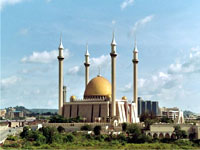 Abuja OverviewAs a purpose-built city, there is something rather contrived
about Abuja, the relatively new capital of Nigeria. Laid out in a
crescent shape, it is situated in the heart of the country in an
area called the Federal Capital Territory; a location chosen for
its neutrality in a country rife with ethnic and religious
clashes. Divided into four districts, with designated business and
residential sectors, the city has leafy, wide roads, high office
towers and large apartment blocks, and is infinitely less congested
and polluted than Lagos, the former capital. Much of the city is
still being built and its population is small, making it a rather
characterless place that lacks the colour and bustle of other
Nigerian cities. However, it must be noted that for tourists not
used to travelling on the African continent, Abuja makes for a far
more gentle introduction to a holiday than in Nigeria than Lagos
does. The dominant feature on the landscape is Aso Rock, an ancient
400-metre high outcrop on the city's outskirts caused by water
erosion, and which looms behind the attractive Government
buildings. There is, however, little else on offer in the way of
tourist attractions in Abuja, apart from nearby Zuma Rock, the
National Mosque, the National Church, Parade Square and the Wuse
Market. Abuja is often used as a jumping-off point for exploring the
rest of the country, and most visitors only take a day or two to
take in its limited sights. Perhaps as it grows in stature and
size, Abuja will become more of an international tourist
destination in its own right. |